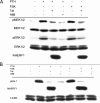Na/H exchange regulatory factor 1, a novel AKT-associating protein, regulates extracellular signal-regulated kinase signaling through a B-Raf-mediated pathway
- PMID: 18272783
- PMCID: PMC2291404
- DOI: 10.1091/mbc.e07-11-1114
Na/H exchange regulatory factor 1, a novel AKT-associating protein, regulates extracellular signal-regulated kinase signaling through a B-Raf-mediated pathway
Abstract
Na/H exchange regulatory factor 1 (NHERF1) is a scaffolding protein that regulates signaling and trafficking of several G protein-coupled receptors (GPCRs), including the parathyroid hormone receptor (PTH1R). GPCRs activate extracellular signal-regulated kinase (ERK)1/2 through different mechanisms. Here, we characterized NHERF1 regulation of PTH1R-stimulated ERK1/2. Parathyroid hormone (PTH) stimulated ERK1/2 phosphorylation by a protein kinase A (PKA)-dependent, but protein kinase C-, cyclic adenosine 5'-monophosphate-, and Rap1-independent pathway in Chinese hamster ovary cells stably transfected with the PTH1R and engineered to express NHERF1 under the control of tetracycline. NHERF1 blocked PTH-induced ERK1/2 phosphorylation downstream of PKA. This suggested that NHERF1 inhibitory effects on ERK1/2 occur at a postreceptor locus. Forskolin activated ERK1/2, and this effect was blocked by NHERF1. NHERF1 interacted with AKT and inhibited ERK1/2 activation by decreasing the stimulatory effect of 14-3-3 binding to B-Raf, while increasing the inhibitory influence of AKT negative regulation on ERK1/2 activation. This novel regulatory mechanism provides a new model by which cytoplasmic adapter proteins modulate ERK1/2 activation through a receptor-independent mechanism involving B-Raf.
Figures







Similar articles
-
NHERF1 regulates parathyroid hormone receptor membrane retention without affecting recycling.J Biol Chem. 2007 Dec 14;282(50):36214-22. doi: 10.1074/jbc.M707263200. Epub 2007 Sep 19. J Biol Chem. 2007. PMID: 17884816
-
NHERF1 regulates parathyroid hormone receptor desensitization: interference with beta-arrestin binding.Mol Pharmacol. 2009 May;75(5):1189-97. doi: 10.1124/mol.108.054486. Epub 2009 Feb 2. Mol Pharmacol. 2009. PMID: 19188335 Free PMC article.
-
Formation of a ternary complex among NHERF1, beta-arrestin, and parathyroid hormone receptor.J Biol Chem. 2010 Sep 24;285(39):30355-62. doi: 10.1074/jbc.M110.114900. Epub 2010 Jul 23. J Biol Chem. 2010. PMID: 20656684 Free PMC article.
-
From parathyroid hormone to cytosolic Ca2+ signals.Biochem Soc Trans. 2012 Feb;40(1):147-52. doi: 10.1042/BST20110615. Biochem Soc Trans. 2012. PMID: 22260681 Review.
-
Noncanonical Sequences Involving NHERF1 Interaction with NPT2A Govern Hormone-Regulated Phosphate Transport: Binding Outside the Box.Int J Mol Sci. 2021 Jan 22;22(3):1087. doi: 10.3390/ijms22031087. Int J Mol Sci. 2021. PMID: 33499384 Free PMC article. Review.
Cited by
-
Genetic Causes of Rickets.J Clin Res Pediatr Endocrinol. 2017 Dec 30;9(Suppl 2):88-105. doi: 10.4274/jcrpe.2017.S008. Epub 2017 Dec 27. J Clin Res Pediatr Endocrinol. 2017. PMID: 29280738 Free PMC article. Review.
-
Ezrin-radixin-moesin-binding phosphoprotein (EBP50), an estrogen-inducible scaffold protein, contributes to biliary epithelial cell proliferation.Am J Pathol. 2009 Mar;174(3):869-80. doi: 10.2353/ajpath.2009.080079. Am J Pathol. 2009. PMID: 19234136 Free PMC article.
-
Site-specific polyubiquitination differentially regulates parathyroid hormone receptor-initiated MAPK signaling and cell proliferation.J Biol Chem. 2018 Apr 13;293(15):5556-5571. doi: 10.1074/jbc.RA118.001737. Epub 2018 Feb 14. J Biol Chem. 2018. PMID: 29444827 Free PMC article.
-
Origins of PDZ Binding Specificity. A Computational and Experimental Study Using NHERF1 and the Parathyroid Hormone Receptor.Biochemistry. 2017 May 23;56(20):2584-2593. doi: 10.1021/acs.biochem.7b00078. Epub 2017 Apr 14. Biochemistry. 2017. PMID: 28376304 Free PMC article.
-
Ixazomib enhances parathyroid hormone-induced β-catenin/T-cell factor signaling by dissociating β-catenin from the parathyroid hormone receptor.Mol Biol Cell. 2017 Jul 1;28(13):1792-1803. doi: 10.1091/mbc.E17-02-0096. Epub 2017 May 11. Mol Biol Cell. 2017. PMID: 28495797 Free PMC article.
References
-
- Ahmed I., Gesty-Palmer D., Drezner M. K., Luttrell L. M. Transactivation of the epidermal growth factor receptor mediates parathyroid hormone and prostaglandin F2α-stimulated mitogen-activated protein kinase activation in cultured transgenic murine osteoblasts. Mol. Endocrinol. 2003;17:1607–1621. - PubMed
-
- Aitken A., Baxter H., Dubois T., Clokie S., Mackie S., Mitchell K., Peden A., Zemlickova E. Specificity of 14-3-3 isoform dimer interactions and phosphorylation. Biochem. Soc. Trans. 2002;30:351–360. - PubMed
-
- Bretscher A., Chambers D., Nguyen R., Reczek D. ERM-Merlin and EBP50 protein families in plasma membrane organization and function. Annu. Rev. Cell Dev. Biol. 2000;16:113–143. - PubMed
-
- Bretscher A., Edwards K., Fehon R. G. ERM proteins and merlin: integrators at the cell cortex. Nat. Rev. Mol. Cell Biol. 2002;3:586–599. - PubMed
-
- Calipel A., Mouriaux F., Glotin A. L., Malecaze F., Faussat A. M., Mascarelli F. Extracellular signal-regulated kinase-dependent proliferation is mediated through the protein kinase A/B-Raf pathway in human uveal melanoma cells. J. Biol. Chem. 2006;281:9238–9250. - PubMed
Publication types
MeSH terms
Substances
Grants and funding
LinkOut - more resources
Full Text Sources
Research Materials
Miscellaneous

